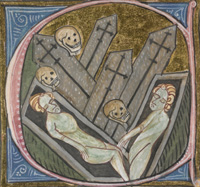 |
 |
 |
 |
 |
 |
 |
|
Fountains Abbey: History
Fountains Abbey: Buildings
|
Concerns for salvation: provision for the soul (6/33)
The belief that prayers and masses celebrated on behalf of one who had died could quicken the soul’s passage to heaven, inspired many men and women across Western Christendom to make gifts to religious houses. It was this sentiment that, at least ostensibly, drew men and women to Fountains as benefactors, requesting spiritual benefits in return for their generosity. These benefits probably included prayers and masses said on the donor’s behalf, perhaps the chance to take the monastic habit before death and to be buried within the precinct, each of which was thought to better one’s chances of salvation. In the first half of the twelfth century, William, nephew of King David of Scotland, granted Fountains land in Kilnsey on the understanding that he might become a lay-brother of the abbey, that his son, Nicholas, might become a monk and that the community would provide for his wife within the religious life.(15) The great northern magnate, William de Stuteville, granted Fountains all his land in Kirkby Ousebourne, which he seems to have developed as a compact estate specifically for the community. In return, William requested burial within the precinct; this was duly carried out in 1203.(16) It was considered that the more devout the monk was, the more effective his prayers and masses would be, bringing greater benefit to the donor. The fact that a number of men and women chose to make grants to Fountains in return for the monks’ spiritual services, certainly suggests that the community was highly esteemed by its neighbours, and that its monks were noted for their spirituality. Donors would also have been attracted by the reputation of the Cistercian Order in Europe, which had gained prominence and fame during the twelfth century. This was largely the achievement of Bernard of Clairvaux, who mingled with popes and kings, preached the Second Crusade, and promoted Cistercian expansion across Western Christendom. Yorkshire men and women who wished to be in some way associated with this highly renowned international Order might choose to become patrons of their local Cistercian abbey at Fountains. Donations were also received from those who had personal connections with the abbey, such as Geoffrey Haget. Geoffrey’s father, Bertram, had been a generous benefactor of Fountains, granting land in Dacre c. 1138. Furthermore, his brother, Ralph, was abbot of Fountains (1190-1203) and in fact encouraged the dying Geoffrey to bestow the village of Thorpe and its appurtenances to the community, along with his body for burial. This was Thorpe Underwood, which lay about twelve miles from Ripon and was later made into a grange.(17) Geoffrey’s generosity to Fountains was no doubt as much inspired by the proximity of his death as his family ties, and his thoughts would at this time have been strongly focused on the afterlife and provision for his soul. |
